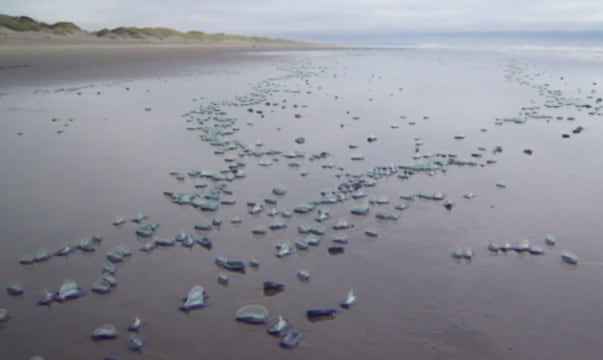 An invasion is afoot along beaches from Oregon to California: Millions of glassy purple, jellyfish-like sea creatures that look like sailboats have been washing ashore.
An invasion is afoot along beaches from Oregon to California: Millions of glassy purple, jellyfish-like sea creatures that look like sailboats have been washing ashore.
Known as "by-the-wind sailors," they typically live in the open ocean, but when warm water and storms draw them near shore, the wind blows them onto beaches, where they die in stinking piles.
 These creatures, whose scientific name is Velella velella, aren't actually jellyfish, but hydrozoans, related to the Portuguese man-of-war. Yet unlike man-of-war, they don't sting humans, though authorities don't recommend touching your face or eyes after handling them.
These creatures, whose scientific name is Velella velella, aren't actually jellyfish, but hydrozoans, related to the Portuguese man-of-war. Yet unlike man-of-war, they don't sting humans, though authorities don't recommend touching your face or eyes after handling them.
Each little sailboat, measuring about 2.75 inches (7 centimeters) long, is in fact a colony of hundreds of smaller organisms, each with a specialized function such as feeding or reproduction, researchers say. [See Amazing Photos of Jellyfish Swarms]
"They sit at the surface of the ocean and have little sails," and their movement depends on which way the wind is blowing, said Richard Brodeur, a fishery biologist at NOAA Fisheries' Newport, Oregon, research station.
Most of the time off the coast of Oregon and California, the winds are blowing toward the South, into the open ocean, Peterson said. But when big storms sweep out of the southwest — like one that hit California two weeks ago — it blows these living flotillas onto the beaches, he said. There, they usually die, giving off a bad smell as they rot, he added.
Tons of the nautical creatures can be found at sea, but they don't always come ashore, Brodeur told Live Science. But recently, huge numbers of them have been washing up on land.
Source
~~~~~~~~~~~~~~~~~~~~~
OCEAN BEACH BULLETIN:
What Are Those Blue, Tentacled Creatures On Ocean Beach?
 Commonly known as by-the-wind sailors, scientists call the palm-sized creatures Velella velella. And although they look a little like jellyfish, California Academy of Sciences scientist Rich Mooi says, they’re not closely related and aren’t even single organisms as jellyfish are.
Commonly known as by-the-wind sailors, scientists call the palm-sized creatures Velella velella. And although they look a little like jellyfish, California Academy of Sciences scientist Rich Mooi says, they’re not closely related and aren’t even single organisms as jellyfish are.
“Velella
Mooi, the Academy of Sciences’ curator of echinoderms, explained that by-the-wind sailors normally live out in the open ocean with their blue, tentacle-like appendages hanging down into the water to collect food and a sail-like crest projecting above the surface. When the wind blows it pushes the animals along by this sail, sometimes pushing them toward land where they accumulate near the edge of the water.
Most of the time, when Velella show up at Ocean Beach, it’s in the springtime when winds usually are strongest.
Read more
More on sailor creatures or velellas
**************************************************************************

No comments:
Post a Comment
Thank you for visiting my blog. Your comments are always appreciated, but please do not include links.